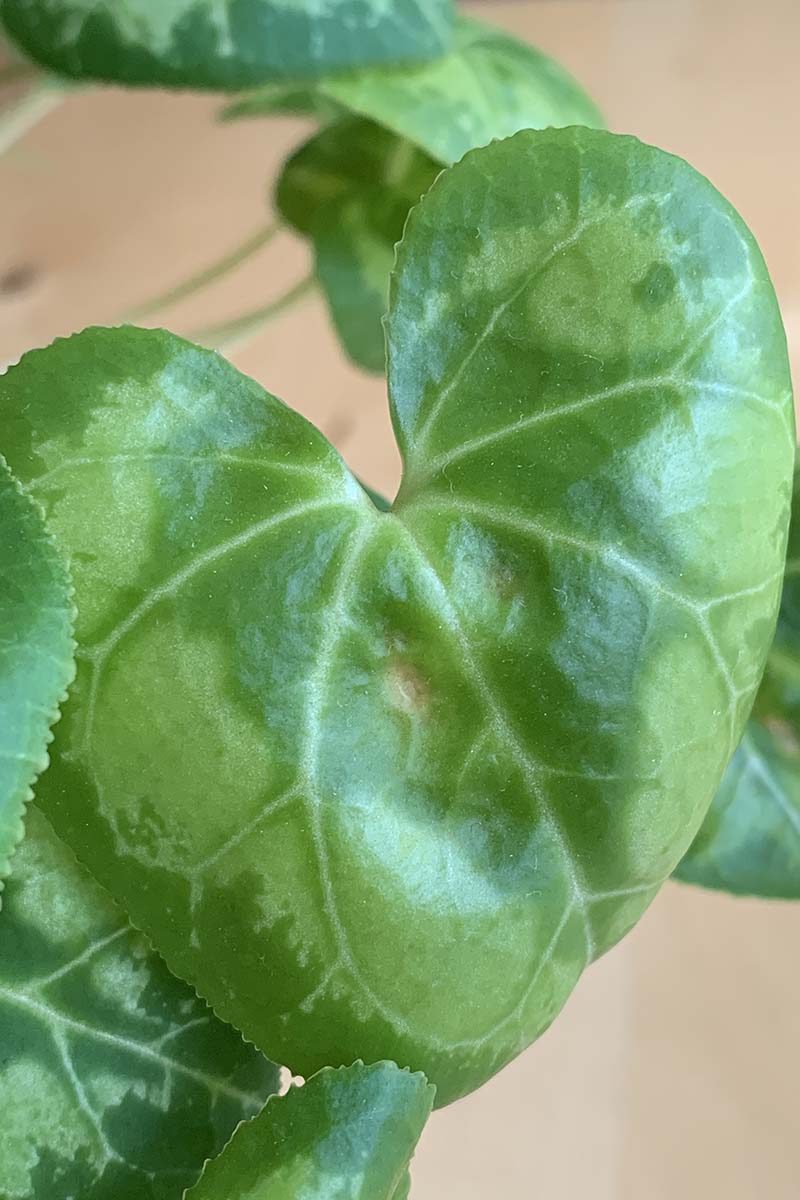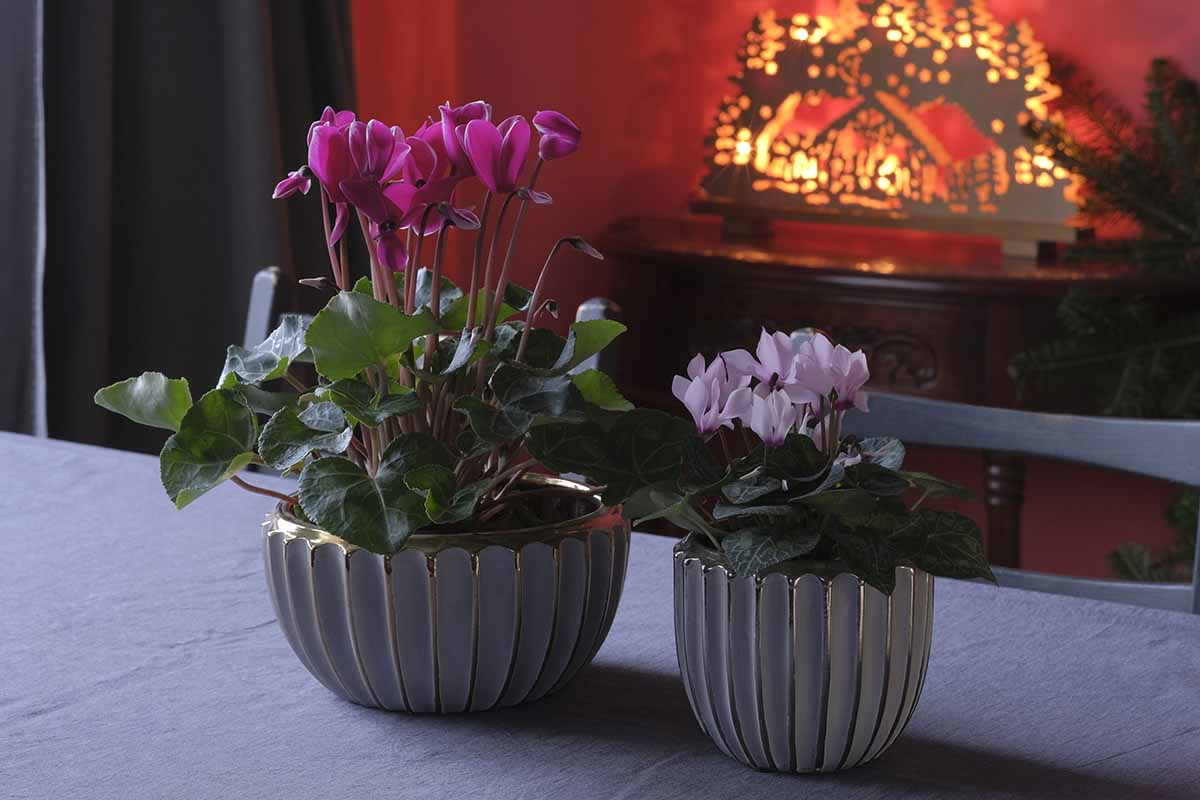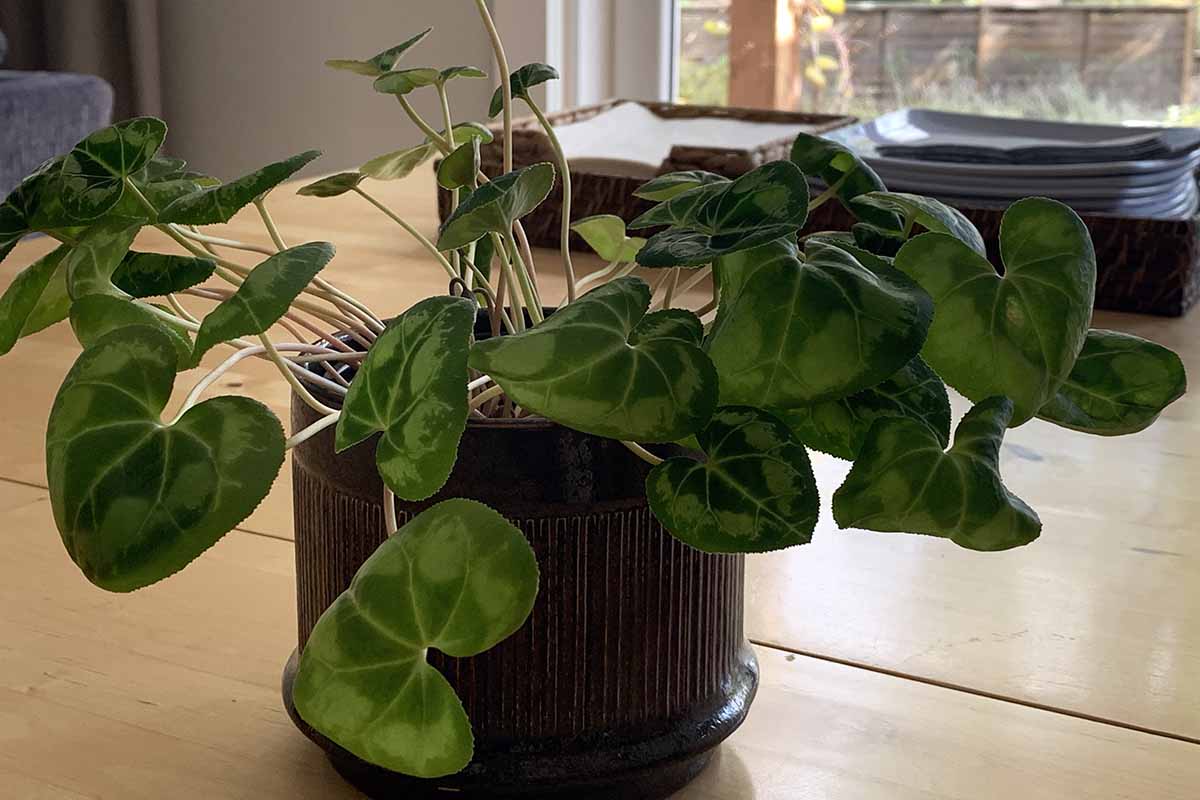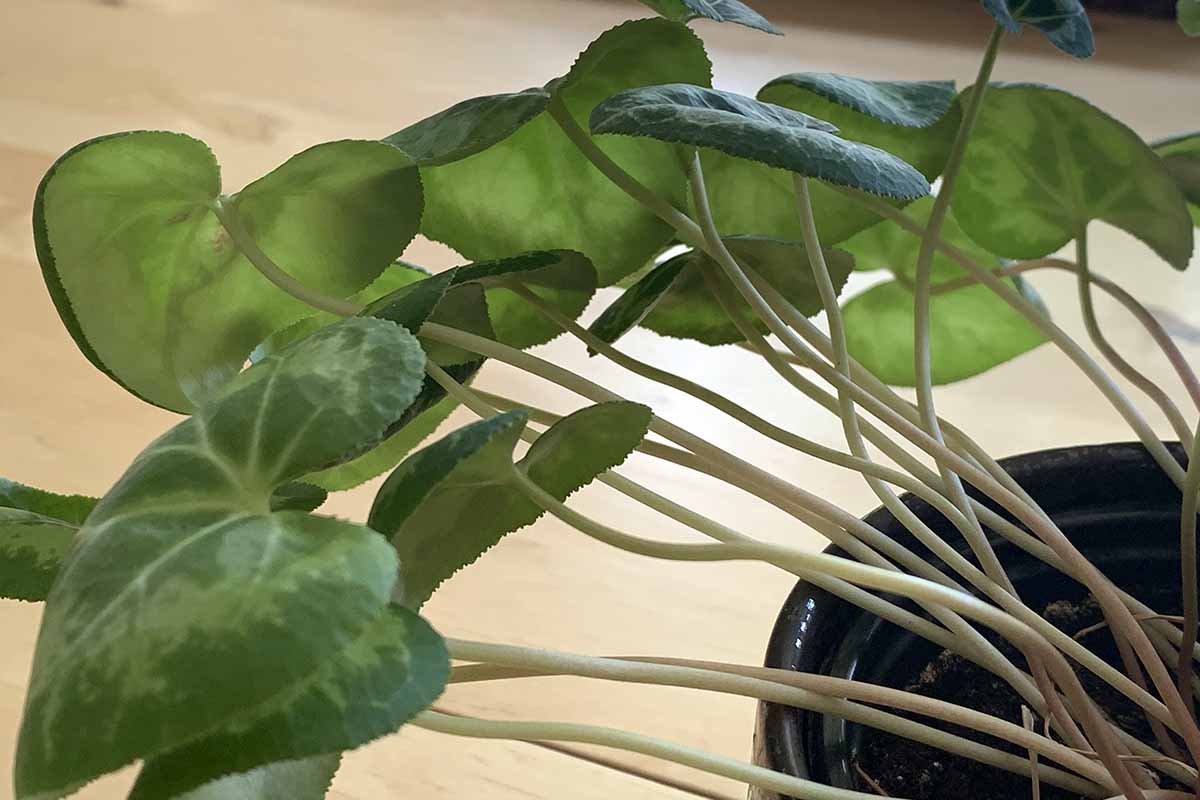During the dark and cold winter months, cyclamen (Cyclamen persicum) houseplants’ bright blooms usually cheer us up.
But sometimes they can begin to look downright droopy. There are a few different reasons for the “flop,” from dormancy to diseases and more.
We link to vendors to help you find relevant products. If you buy from one of our links, we may earn a commission.
For full information about cyclamen care, check out our growing guide. In this article, we’ll specifically explore the causes of drooping and wilting, and offer solutions to help.
We’ll get to the root of the problem together and have your C. persicum perking up in no time.
Cyclamen are stunning flowering plants that brighten up any space with their colorful blooms But you may notice your cyclamen’s stems and leaves starting to droop and wilt, If you’ve wondered “why is my cyclamen drooping?” read on to learn the common causes and fixes to revive your plant
Overwatering
Excessive watering is one of the most common reasons behind a drooping cyclamen. These plants prefer moist but not soggy soil. If kept too wet, the roots can rot leading to wilted, yellowing leaves. The stems will start to sag and the flowers droop as the plant declines.
To fix an overwatered cyclamen, allow the soil to dry out completely between waterings Pour out any excess water in the saucer beneath the pot after watering Move the plant to a spot with good airflow to allow the soil and plant to dry out faster. Remove any rotted or mushy tubers and repot with fresh soil if needed.
Underwatering
While overwatering is more common, underwatering can also cause cyclamen to droop. If the soil dries out too much between waterings, you may notice the leaves flagging and flowers drooping from dehydration stress.
Revive an underwatered cyclamen by giving it a good, thorough soaking. Allow excess water to drain fully from the pot. Increase watering frequency going forward, taking care not to overdo it. The soil should be kept evenly moist but not saturated.
Insufficient Light
Cyclamen prefer bright, filtered light. Too little light leads to weak, stretched out stems and drooping flowers struggling to reach for the sun.
Give a droopy cyclamen from insufficient light more sunlight. An east or west window is ideal. Rotate the plant periodically so all sides get sun exposure. Outdoor cyclamen may need a sunnier garden location. Consider adding a grow light if adequate natural light isn’t available.
Excessive Heat
Heat stress causes rapid wilting and drooping in cyclamen. Hot, dry air from heating vents or direct sun baking the container can quickly distress the plant.
Move an overheated cyclamen to a cooler spot out of direct sun. Mist the leaves often to increase humidity around the plant. Keep the soil moist but not wet. Lowering the temperature can perk up a heat stressed cyclamen within a few days.
Cold Drafts
On the flip side, cyclamen don’t tolerate cold well either. Chilly drafts from windows or air conditioning vents can shock the plant, causing the flowers and leaves to shrivel and droop.
Protect your cyclamen from cold exposure. Move pots away from drafty windows or vents. Keep indoor temperatures above 60°F (16°C) for best results. Outdoors, make sure to bring containerized cyclamen plants indoors before frost hits.
Gray Mold
One of the most devastating fungal diseases in cyclamen is gray mold, caused by the pathogen Botrytis cinerea. It manifests first as drooping flowers and leaves, which then turn gray or brown. Fluffy gray fungal growth may appear on affected tissue. Entire plants can quickly collapse from the infection.
Improve air circulation around plants to prevent gray mold. Water early in the day so foliage dries quickly. Remove and discard any severely infected plants. Use a fungicide spray early on to treat plants with some spotting. But don’t use fungicides once gray mold has taken hold.
Natural Dormancy
As spring arrives, it’s normal for cyclamen to start yellowing, drooping, and going dormant. This seasonal dieback of the foliage and flowers occurs as the plant enters a period of summer dormancy. New growth will emerge again in fall.
Let the leaves and stems yellow and droop naturally as the cyclamen goes dormant. Reduce watering but don’t let the tubers dry out completely. Store dormant tubers in a cool place until ready to resume growth. Repot and water normally once new leaves appear in late summer or fall.
Repotting Shock
Repotting at the wrong time or improperly can shock cyclamen, leading to transplant droop. Too much handling of the tubers or using a much larger pot than needed causes stress.
When repotting cyclamen, wait until the plant is going dormant after flowering. Use a container only 1-2 inches larger than the root ball. Handle the tubers gently and disturb the roots as little as possible. This will minimize transplant shock and drooping after repotting.
Pests
While relatively pest-free, cyclamen can be damaged by sucking insects like aphids, mealybugs, and thrips. Their feeding saps plant juices, causing flowers and leaves to shrivel and wilt.
Inspect plants routinely for signs of infestation. Remove pests by hand or use insecticidal soap or neem oil. Prevent ants from farming aphids on cyclamen by applying sticky barriers to pot legs or hanging yellow sticky traps nearby.
Diseases
In addition to gray mold, other fungal diseases like leaf spot, root rot, and crown rot can lead to drooping in infected cyclamen plants. Bacterial and viral diseases can also cause wilting and decline.
Discard any plants with advanced disease infections. Isolate new plants and inspect them thoroughly for issues before bringing home. Provide good air circulation. Avoid overhead watering and crowding plants. Clean tools and repot with fresh soil yearly.
The Takeaway
Several cultural, environmental, and pest factors can lead to drooping flowers and leaves in cyclamen plants. Most commonly, overwatering, low light, temperature extremes, pests, and diseases are responsible. With some adjustments to care, light, watering, and location, a droopy cyclamen can often be revived. But discard diseased plants promptly to avoid spreading issues further. Paying close attention and addressing problems early helps keep these flowering beauties healthy and thriving.

Too Much or Not Enough Light
Imagine being at a concert. Not so loud that it hurts your ears and throws you off for days, but just the right amount so that you can really feel the music, right?
Well, that’s how cyclamens feel about light. They want the “volume” set just right – a bright but soft indirect exposure.
As if to say, “We could use a bit more brightness here!” cyclamens may start to slump in places where the days are short and dark, especially in the winter.
Your job is to give your plants enough light, but keep in mind that too much light can hurt them too. Too little light can make them wilt and droop.
Exposure to direct sunlight will make them droop faster than you can say “shade. ” It can even cause leaves to dry out and wither.

What is the best place for these delicate beauties? A window that faces east will give them morning light and keep them out of the hot sun during the day.
It can be too much for these plants, even in the winter, when the sun comes in through a south-facing window.
As long as your plants get four to six hours of indirect light a day, they should have green, happy leaves and flowers.
By providing the right amount of light for your cyclamen, you’ll help it grow well and avoid the awful droop.
Cyclamens are sensitive to temperature. Growing outdoors in their native regions, C. persicum plants are in their active growing phase during winter.
As houseplants, they do best with daytime temperatures between 60 and 65°F (18°C).

If your cyclamen is performing poorly, the plant could be too warm. Now, I’m not saying you need to keep your home at a chilly 60°F all winter long. That’s a bit too cold, even for my Scandinavian blood!.
What I’m saying is that you should avoid direct heat from furnace vents, heat registers, or fireplaces. You might like to be toasty warm, but your plant will not.
If your cyclamen is drooping or wilting, it could be asking you to turn down the heat. Set your thermostat to a reasonable level of heat and put your plant somewhere it won’t get too hot.
If you don’t lose power or leave your house unattended, don’t worry about the temperature dropping too low. If your home gets too cold, all your houseplants will likely freeze and fail, and so will you!.
Keep your cyclamen indoors where it won’t freeze, but don’t let it get too warm either.
Common Causes of Cyclamen Drooping
If you’re ready, let’s jump right in and get started!
Seasonal dormancy is the most obvious cause of drooping in cyclamen plants. The onset of this phase can appear worrisome, but it’s completely normal and natural.
So, what exactly is going on with this whole dormancy thing? Let me explain.
C. originating from the Mediterranean area, where plants bloom in the cool and damp winter months and rest and slow down during the dry, hot summers.
This plant usually goes into dormancy in late spring or early summer in colder places like the US and Canada, where it lives indoors.

Before the plant goes into dormancy, its leaves will likely start to turn yellow, become limp, and dry out.
It’s hard to say exactly when this phase will start because our homes and local climates can change.
But if your plant was doing well not long ago and the dates on your calendar match up, it’s likely that everything is fine and your cyclamen is fine.
If the plant is going to sleep, the leaves will hang down. Just accept it and go with the flow!
But remember that you’ll need to take extra care of your houseplant during this time. Read our guide for more information on how to do this.
If you’ve ruled out dormancy, there may be other problems with your plant’s health, such as poor nutrition. When cyclamens aren’t fertilized properly, they might begin to droop.

Even though these houseplants don’t need a lot of food, giving them the right nutrients in the right amounts during the growth and flowering stages can make a huge difference in their survival.
But here’s the catch: too much can be bad for the plant; if it gets too much fertilizer, it may wilt.
Too much fertilizer can cause your plant to produce new growth quickly. There will be a lot of lush, green growth above ground, but the tuber and roots will be struggling to keep up.
The roots will not be able to support the new, beautiful growth, and the leaves and flowers will start to wilt and die. So, what should you do?.
For our cyclamen friends, it’s important to pick the right fertilizer and use it at the right time.
Find a product that is formulated for flowering plants.
Look for a nutrient ratio that goes easy on nitrogen (N) and is generous with phosphorus (P). Think along the lines of a 5-10-5 (NPK) blend, and you’ll be right on track.
If you’re an online shopper, check out Down to Earth Rose and Flower Mix, available at Arbico Organics.
This all-natural, granular fertilizer has a ratio of 4-8-4 and is ideal for regular application.
It should get better if you switch to this if your cyclamen is wilting and you’re not fertilizing it or are using a different product with a different nutrient ratio.
Only apply fertilizer during the active growing season, not during the dormant phase.
Most likely, you’ll need to feed your houseplant every two weeks. But always read the package and follow the directions exactly, as the time can change depending on the product you choose.
If you’ve been overfertilizing, back off for a bit. Let your plant heal for three to four weeks without feeding it. Then start feeding it again at the right time and in the right amount.
If you haven’t been fertilizing right, you should start to see results soon after you start your new plan.
A Comprehensive Guide On Cyclamen Plant Care! (6-TRICKS*)
FAQ
How to revive a droopy cyclamen?
What does an overwatered cyclamen look like?
How do you revive a cyclamen?
How do you bring a cyclamen back to life?
Why is my Cyclamen plant drooping?
In conclusion, drooping cyclamen plants can be a result of either under-watering or over-watering. By examining the leaves, checking the soil moisture, considering the weather conditions, and adjusting your watering routine, you can determine the cause of the drooping and take appropriate action to revive your cyclamen plant.
What are the causes of drooling?
Common causes of drooling like side sleeping, stomach sleeping, gastroesophageal reflux disorder, obstructive sleep apnea, sinus infection, allergies, congestion, stroke, Parkinson’s disease, and bell’s palsy.
Do Cyclamen droop?
Unlike other perennials, cyclamen thrive best in cool temperatures with high humidity. Too high or too low temperatures can lead to stress, causing them to droop. Cyclamen thrive best with filtered sunlight, so exposure to direct sunlight for more than six hours can burn their leaves and cause them to die.
Why is my Cyclamen floppy?
If your cyclamen is floppy, the air in your home might be a bit too dry for the plant. Here’s a simple fix: Find a shallow tray and fill it with pebbles, then add water just below the pebble line. Place your cyclamen pot atop this setup. As the water evaporates, it’s like giving your plant a refreshing facial mist.
Do cyclamen plants droop & Wilt?
Tip: Employ cultural, mechanical, or natural control methods to address pest infestations effectively. Pot Size: Over time, cyclamen plants may outgrow their pots, leading to drooping or wilting. Repotting your plant every two to three years is recommended to prevent root binding and support healthy growth.
Why does my Cyclamen Wilt?
There are several reasons why your cyclamen might wilt, from dormancy to pests and diseases. In this in-depth guide, we’ll delve into the common causes of drooping cyclamen plants and provide practical solutions to help you revive them.
- The Ultimate Guide to Growing Strawberries in Raised Beds - August 8, 2025
- No-Dig Garden Beds: The Easiest Way to Grow a Beautiful Garden - August 6, 2025
- How to Protect and Preserve Wood for Raised Garden Beds - August 6, 2025
